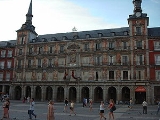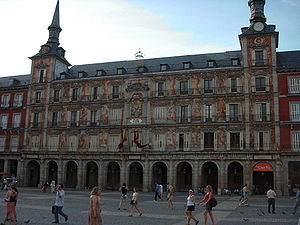
Casa de la Panadería
Encyclopedia

Madrid
Madrid is the capital and largest city of Spain. The population of the city is roughly 3.3 million and the entire population of the Madrid metropolitan area is calculated to be 6.271 million. It is the third largest city in the European Union, after London and Berlin, and its metropolitan...
. It is four stories high, the ground floor comprising porticos and the top floor in the form of an attic, with its sides crowned by angular towers.
History
The Casa de la Panadería (Bakery House) was erected during the construction of the Plaza Mayor. Juan Gómez de MoraJuan Gómez de Mora
Juan Gómez de Mora was a Spanish architect. His father, also Juan Gómez, was court painter to Philip II of Spain and brother to the architect Francisco de Mora....
was in charge of its construction, which was completed in 1619. After the second burning of the plaza in 1670, the building was rebuilt by Tomás Román, who commissioned painters Claudio Coello
Claudio Coello
Claudio Coello was a Spanish Baroque painter. Influenced by many other artists, including Diego Velázquez who was also of Portuguese descent, Coello is considered the last great Spanish painter of the 17th century....
and José Jiménez Donoso to decorate the interior and the frescoes on the facade. After the third burning of the plaza in 1790, the surviving Casa de la Panadería served as a reference for Juan de Villanueva
Juan de Villanueva
Juan de Villanueva was a Spanish architect. Alongside Ventura Rodríguez, Villanueva is the best known architect of Spanish Neoclassicism....
's reconstruction of the rest of the plaza.
La Casa de la Panadería has suffered several remodelings since then, most notably that carried out by Joaquín María de la Vega in 1880.
In 1988, the Madrid City Council convened a public contest to undertake the decorating of the facade, due to the severe deterioration of the paintings done by painter and ceramicist Enrique Guijo in 1914. The artists Guillermo Pérez Villalta, Sigfrido Martín Begué, and Carlos Franco were invited to participate in the contest. Carlos Franco won with a design based on mythological figures such as Cybele
Cybele
Cybele , was a Phrygian form of the Earth Mother or Great Mother. As with Greek Gaia , her Minoan equivalent Rhea and some aspects of Demeter, Cybele embodies the fertile Earth...
, Proserpine
Proserpina
Proserpina or Proserpine is an ancient Roman goddess whose story is the basis of a myth of Springtime. Her Greek goddess' equivalent is Persephone. The probable origin of her name comes from the Latin, "proserpere" or "to emerge," in respect to the growing of grain...
, Bacchus
Dionysus
Dionysus was the god of the grape harvest, winemaking and wine, of ritual madness and ecstasy in Greek mythology. His name in Linear B tablets shows he was worshipped from c. 1500—1100 BC by Mycenean Greeks: other traces of Dionysian-type cult have been found in ancient Minoan Crete...
, and Cupid
Cupid
In Roman mythology, Cupid is the god of desire, affection and erotic love. He is the son of the goddess Venus and the god Mars. His Greek counterpart is Eros...
, as well as others invented by the artist, interwoven into the history of Madrid and the Plaza Mayor. The work to paint Carlos Franco's frescoes was carried out in 1992.
Uses
In the beginning, its lower levels housed the main bakery of the house. From 1732 on, it served as offices for the Peso Real and the Fiel Contraste. Between 1745 and 1774, the Real Academia de Bellas Artes de San FernandoReal Academia de Bellas Artes de San Fernando
The Real Academia de Bellas Artes de San Fernando , located on the Calle de Alcalá in the heart of Madrid, currently functions as a museum and gallery....
(Royal Academy of Fine Arts of San Fernando) kept its headquarts there, as did the Real Academia de la Historia
Real Academia de la Historia
Real Academia de la Historia is a Spanish institution based in Madrid that studies history "ancient and modern, political, civil, ecclesiastical, military, scientific, of letters and arts, that is to say, the different branches of life, of civilisation, and of the culture of the Spanish...
(Royal Academy of History) from 1774 to 1871. At the end of the 19th century, the Madrid City Council took charge of La Casa de la Panadería, converting it into the second Casa Consistorial de la Villa. Later one it became the headquarters of the Municipal Library and Municipal Archives. Still later, it housed various municipal offices as well as institutions like the Centro Cultural Mesonero Romanos. Today its premises are occupied by the Madrid Tourist Board and the ground floor houses the Madrid Tourism Center.
Commemorative Plaques
 |
 |
| Reinando Felipe II y por su mandado se deshizo y derribó la plaza antigua de esta villa y se labró de nuevo en tiempo de dos años, siendo Presidente de Castilla Don Fernando de Acebedo Arzobispo de Burgos y superintendente de Castilla el licenciado Pedro de Tapia del Supremo Consejo de Castilla y de la general Inquisición y Corregidor Don Francisco de Villacís caballero de la Orden de Santiago y Regidores Comisarios Juan Fernández y Don Gabriel de Ocaña de Alarcón caballero de la Orden de Santiago, Juan de Piñedo, Francisco Enríquez de Villacorta y Don Fernando Vallejo Gentil Hombre de la casa de Su Majestad u se acabó en el año 1619. | Reinando Don Carlos II y gobernando la Reina Doña Mariana de Austria su madre y tutora, habiéndose quemado esta Real Casa de la Panadería el día dos de agosto de 1672, se reedificó desde los cimientos mejorada en fábrica y traza siendo Presidente de Castilla Pedro Nuñez de Guzmán Conde de Villaumbrosa y Castronuevo y superintendente de la obra Don Lorenzo Santos de San Pedro del Consejo Real de Castilla, caballero de la Orden de Santiago, y Corregidor de esta villa Don Baltasar de Rivadeneira y Cuñiga Marques de la Vega del Consejo de hacienda y caballero de la misma orden y Regidores Comisarios Don Gerónimo Dalmao y Casanaey y Rafael San Guineto Don Tomás de Álava y Arigón y Don Andrés Martínez Navarite caballeros del mismo Orden y Caballería de Santiago. Acabose en diecisiete meses. Año de 1674. |
Spanish Coat of Arms
Found at the top center of La Casa de la Panadería are the royal Spanish arms from the reign of Carlos II. Note that the arms of PortugalPortugal
Portugal , officially the Portuguese Republic is a country situated in southwestern Europe on the Iberian Peninsula. Portugal is the westernmost country of Europe, and is bordered by the Atlantic Ocean to the West and South and by Spain to the North and East. The Atlantic archipelagos of the...
are missing, as Portugal had recently become independent from Spain's rule.
This shield is composed of the arms of Castile
Kingdom of Castile
Kingdom of Castile was one of the medieval kingdoms of the Iberian Peninsula. It emerged as a political autonomous entity in the 9th century. It was called County of Castile and was held in vassalage from the Kingdom of León. Its name comes from the host of castles constructed in the region...
and León
León (historical region)
The region of León or Leonese region is a hitoric territory defined by the 1833 Spanish administrative organisation. The Leonese region encompassed the provinces of Salamanca, Zamora, and León, now part of the modern Spanish autonomous community of Castile and León.-Leonese History:Until 1833, the...
in the first quarter, the arms of Aragón
Aragon
Aragon is a modern autonomous community in Spain, coextensive with the medieval Kingdom of Aragon. Located in northeastern Spain, the Aragonese autonomous community comprises three provinces : Huesca, Zaragoza, and Teruel. Its capital is Zaragoza...
and Sicilia in the second, the arms of Austria
Austria
Austria , officially the Republic of Austria , is a landlocked country of roughly 8.4 million people in Central Europe. It is bordered by the Czech Republic and Germany to the north, Slovakia and Hungary to the east, Slovenia and Italy to the south, and Switzerland and Liechtenstein to the...
and Burgundy modern in the third, and the arms of Burgundy ancient and Brabant in the fourth. The arms of Flanders
Flanders
Flanders is the community of the Flemings but also one of the institutions in Belgium, and a geographical region located in parts of present-day Belgium, France and the Netherlands. "Flanders" can also refer to the northern part of Belgium that contains Brussels, Bruges, Ghent and Antwerp...
and Tyrol
County of Tyrol
The County of Tyrol, Princely County from 1504, was a State of the Holy Roman Empire, from 1814 a province of the Austrian Empire and from 1867 a Cisleithanian crown land of Austria-Hungary...
are found in the lower escutcheon on the nombril point, and the symbol for Granada
Granada
Granada is a city and the capital of the province of Granada, in the autonomous community of Andalusia, Spain. Granada is located at the foot of the Sierra Nevada mountains, at the confluence of three rivers, the Beiro, the Darro and the Genil. It sits at an elevation of 738 metres above sea...
in the center of the shield. The arms of Portugal would have been situated in an escutcheon on the honor point, between those of Castile and León and those of Aragón.
See also
- Plaza Mayor, Madrid

